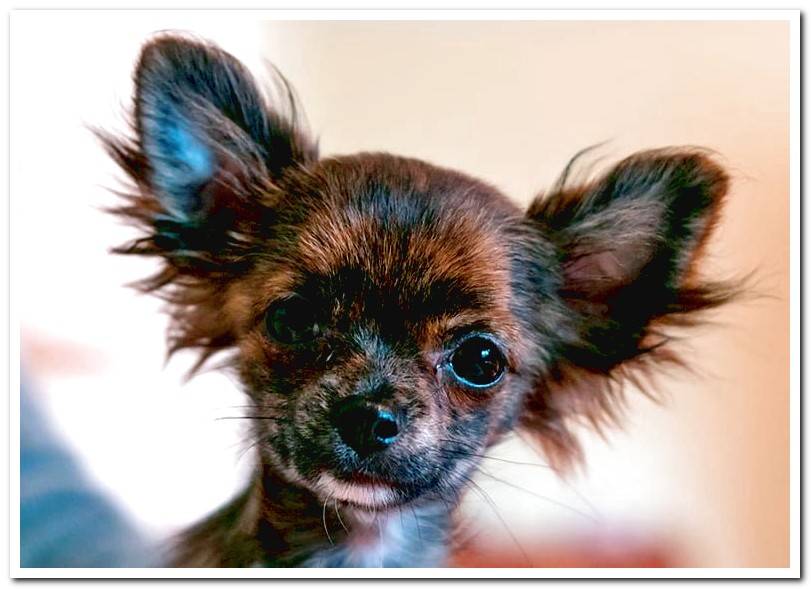
We can define hydrocephalus as the accumulation of cerebrospinal fluid in the brain. Only this data already allows us to intuit the severity of this disorder, which, of course, will need veterinary treatment.
Hydrocephalus, luckily, is not a very common pathology, but it can especially affect specimens of the smallest breeds. Next we will see the symptoms that it produces and what is its treatment.
Index of contents
- 1 What is canine hydrocephalus?
- 2 What causes hydrocephalus in dogs?
- 3 Which dogs have hydrocephalus?
- 4 Hydrocephalus symptoms in dogs
- 5 Subclinical hydrocephalus
- 6 How is hydrocephalus diagnosed in a dog?
- 7 What is the treatment for canine hydrocephalus?
- 8 Is hydrocephalus cured?
- 9 Care for a dog with hydrocephalus
What is canine hydrocephalus?
As its name suggests, hydrocephalus is the excessive accumulation of cerebrospinal fluid (CSF) in the brain. This fluid is what bathes the brain and spinal cord.
Hydrocephalus occurs when we find more than normal in the brain ventricles. These are cavities inside the brain where the CSF circulates. This condition increases its size, which presses the cerebral cortex against the skull and damages it.
What causes hydrocephalus in dogs?
Many of the cases of hydrocephalus that occur have a congenital cause, which means that animals are already born with this condition. They will manifest symptoms before six months of life. A minority of those affected acquires this pathology as a result of blows or infections or tumors in the brain.

Which dogs have hydrocephalus?
All dogs can be affected by this disease, but there are some breeds where the risk of suffering from it is higher.
- Maltese
- Yorkshire
- Chihuahua
- Lhasa apso
- Pomeranian
- Boston terrier
- Pug
- Pekingese
- Bulldog
They are more prone to congenital hydrocephalus. We see that they are small size breeds, miniature or brachycephalic.
In them it is possible to carry out studies of the brain by means of electroencephalography. In this way, only healthy specimens can be dedicated to breeding. This would reduce the incidence of the disease.
Hydrocephalus symptoms in dogs
It is important that we recognize the most common symptoms of hydrocephalus, especially if our dog is among the breeds that we have mentioned as having a higher risk of suffering from this problem. They are as follows:
- Seizures
- Partial or total blindness.
- Squint.
- Impaired cognitive abilities, which encompass all mental processes to perceive and process the information received.
- Strange behaviors.
- Depression.
- Ride in circles.
- Head pressure against surfaces.
- Puppies with congenital hydrocephalus have a characteristic enlarged head, although it does not have to appear at birth.

Subclinical hydrocephalus
This type of hydrocephalus is the one that occurs when there is an increase in the size of the cerebral ventricles but none of the symptoms we mentioned develop.
How is hydrocephalus diagnosed in a dog?
To confirm a diagnosis of hydrocephalus, the vet may use tests such as radiography, ultrasound, computed tomography or magnetic resonance imaging. It is not always possible to have all of them. In many cases a presumptive diagnosis is made, that is, based on the clinic and response to treatment.
What is the treatment for canine hydrocephalus?
The goal of treatment is to control the production of cerebrospinal fluid. For this the vet will prescribe corticosteroids and diuretics. In some cases it is essential to resort to surgery to drain excess fluid, although you should know that it can have serious complications.
Intracranial operations must be carried out by specialized veterinaryns. They are very delicate interventions. Likewise the postoperative requires careful care. The dogs remain hospitalized for about three days, after which we will continue the recovery at home, according to veterinary recommendations.
It is very important to seek assistance as soon as we perceive any of the symptoms mentioned. Starting treatment early, if possible before brain damage occurs, improves the prognosis for hydrocephalus.

Is hydrocephalus cured?
It is possible to treat hydrocephalus, so it is important that we take the dog to the vet quickly and do not let the symptoms pass by thinking that they have no cure or that they will solve themselves.
The prognosis is reserved and will depend on the speed with which it is diagnosed, the early start of treatment and the damage that each affected dog present at the brain level. In dogs that have recovered from hydrocephalus, learning disabilities may persist as a sequel. In general they seem clumsy.
Care for a dog with hydrocephalus
Whether the option chosen for treatment is surgery or medication, it is important that we take into account the following recommendations. They are based on maintaining the quality of life of the animal and preserving as much as possible its brain:
- It is not recommended to offer the dog rope or teether toys that can make him shake his head suddenly.
- It is important to avoid symptoms such as coughing
or vomiting due to the exertion of the head. - Walking the dog is recommended with harness and not with a necklace.
- It is essential that the dog is well nourished and hydrated.
- Avoid sudden changes.
- Of course, veterinary follow-up must be exhaustive to adjust the medication or treat any deterioration early.
